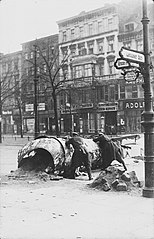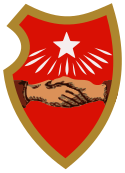Powstanie Spartakusa (1919)
| rewolucja listopadowa | |||
 Barykada na Große Frankfurter Straße w Berlinie w czasie powstania Spartakusa | |||
| Czas | |||
|---|---|---|---|
| Miejsce | |||
| Terytorium | |||
| Wynik | zwycięstwo strony rządowej | ||
| Strony konfliktu | |||
| Dowódcy | |||
| |||
| Straty | |||
| |||
Powstanie Spartakusa (niem. Spartakusaufstand lub Januaraufstand) – powstanie wywołane 5 stycznia 1919 przeciw rządowi rewolucyjnemu złożonemu z członków Socjaldemokratycznej Partii Niemiec (SPD) i trwające do 15 stycznia. Jeden z epizodów rewolucji listopadowej.
Tło historyczne
Podczas Powszechnego Kongresu Rad Robotniczo-Żołnierskich w Berlinie trwającego w dniach 16–21 grudnia 1918, w którym to kongresie wzięli udział zarówno politycy SPD, jak i USPD ustalono, że władza należeć będzie jedynie do rządu rewolucyjnego, nazwanego później Radą Centralną, a nie, jak chciało USPD do rad robotniczych[1]. W następnych dniach politycy USPD ustępowali ze swoich urzędów na znak protestu, niektórzy z nich 1 stycznia 1919 powołali nową partię – Komunistyczną Partię Niemiec, która wraz z istniejącym wcześniej Związkiem Spartakusa podjęła decyzję o wybuchu powstania w Berlinie[2].
Przebieg powstania
Bezpośrednią przyczyną powstania było usunięcie za działalność przeciw rządowi polityka USPD ze stanowiska prezydenta berlińskiej policji Emila Eichhorna[2]. Walki wybuchły 5 stycznia i objęły ulice Berlina. Nowo powołany minister obrony narodowej Gustav Noske wydał rozkaz Reichswehrze i Freikorpsom stłumienia rewolty, odbicia ulic Berlina i spacyfikowania powstańców. Liczba ofiar powstania wyniosła 156 osób, zamordowano również przewodniczących KPD – Różę Luksemburg i Karla Liebknechta, nieco później Leona Jogichesa, a kilka dni później ich ciała wrzucono do Landwehrkanal. Było to równoznaczne z upadkiem powstania[2].
Galeria
Żołnierze na Bramie Brandenburskiej
Ciężki moździerz 25 cm schwerer Minenwerfer używany przez wojsko na Alexanderplatz
Żołnierze z miotaczami ognia na ulicach Berlina
Przypisy
- ↑ Allgemeiner Kongreß der Arbeiter- und Soldatenräte Deutschlands. Vom 16. bis 21. Dezember im Abgeordnetenhause zu Berlin. Stenogram wydany przez Zentralrat der sozialistischen Republik Deutschlands, Berlin 1919.
- ↑ a b c W. Czapliński, A. Galos, W. Korta Historia Niemiec s. 620-621 (1991) Zakład Narodowy Imienia Ossolińskich.
Media użyte na tej stronie
Flaga Niemiec o proporcjach 3:2
A captured British Mk IV female tank being used by the Government troops during the Sparticist's riots. Note the two German crosses and skull and crossbones on the side of the tank. The Spartacus League renamed itself the German Communist Party and called for a general strike of the workers in January 1919. A volunteer group of 3,000 former soldiers, called the Free Corps, was called in to restore order. They fought against the Red Front (Communist) soldiers in hand to hand combat on the streets of Berlin. The leaders of the Communists, Liebknecht and Luxemburg, were dragged from their hiding place and murdered in the Tiergarten park in the center of the city. Luxemburg's body was thrown into the Landwehr Canal. A monument to Luxemburg now stands in the Tiergarten.
Title: Flame-throwers, Berlin Abstract/medium: 1 negative : glass ; 5 x 7 in. or smaller.
Autor: R-41, Licencja: CC BY-SA 3.0
Logo of the Communist Party of Germany
Große Straßenkämpfe in Berlin während des Generalstreiks. Schwere Minenwerfer auf dem Alexanderplatz.
*Street fights between government troops and revolutionary guards in Berlin, in September 1919.
- Getty Caption:"Street fighting in Berlin between Government troops and Spartacists, during the Spartacist uprising which followed Germany's defeat in World War I. "
Machine-gun position on the quadriga of the Brandenburger Tor, Berlin, during the Spartacist uprising; ; Landesarchiv Berlin
Proposed War ensign of Germany, 1919
(c) Bundesarchiv, Bild 183-S60769 / CC-BY-SA 3.0
Zentralbild Revolution 1918/19 in Deutschland Berlin 1919 Konterrevolutionäre Truppen unter dem Befehl von Oberst Wilhelm Reinhard in der Straße "Unter den Linden".
823-19The red flag – international symbol of the working class. (3:5 ratio)
Autor: Alfred Grohs, Licencja: CC BY 3.0
Erst in der Vergrößerung dieses Scans der originalen Echtfoto-Ansichtskarte des Urhebers Alfred Grohs werden Details der Szenerie erkennbar, die eine andere Betrachtungsweise zulassen: Wenn auch die Schärfe der ursprünglichen Aufnahme vergleichsweise enttäuschend ist, so ist die versammelte Gruppe von Schaulustigen im Hauseingang neben dem Bekleidungsgeschäft ("Damen-Mäntel") an der "Große Frankfurter Straße" ein Indiz dafür, dass die auf dem Foto scheinbar zu sehende aktuelle Kampfhandlung der Barrikadenkämpfe während der Novemberrevolution offenbar nicht mehr lebensgefährlich ist. Eine nachgestellte Aufnahme, während der Eltern ihre Kinder zuschauen lassen? Der Erkenntnisgewinn gegenüber dem vom deutschen Bundesarchiv gestifteten Digitalisat ist jedoch enorm: Neben weiteren Details konnte über Wikimedia Commons bisher sowohl der Name des Fotografen als auch der genaue Ort der Aufnahme (auf der heutigen Karl-Marx-Allee) identifiziert werden.
Autor: Dahn, Licencja: CC BY-SA 4.0
Logo of the Independent Social Democratic Party of Germany (USPD), from a 1920 lapel at the German Historical Museum, LEMO collection.



















